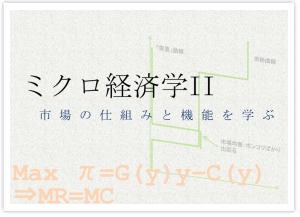Microeconomics II
| Lecturer | Makoto HANAZONO, Associate Professor |
|---|---|
| Department | School of Economics / Graduate School of Economics, 2011 Spring |
| Recommended for: | Economics students (2・1.5 hours. / session One session / week 15 weeks / semester) |

Course Overview
To understand the structure and the working of an economy, it is essential to investigate what motivates each individual economic agent's decision and how decision-making interacts. Microeconomics is a study of individual decision making and its social consequences, and contributes to our understanding of how an economy performs. This course is intended to provide with basic elements of microeconomics, to the students who have already learnt elementary consumer and producer theories and the equilibrium analysis of competitive markets
Key Features
I think that Microeconomics serves as "the grammar" of economic studies, and therefore, I employ repetition of the course materials and practice through exercises in class, as in teaching a language.
In 2008, I newly adopted in-class quizzes to check the students' understandings. The class size is a problem, though; well over 200 students. It is very hard to teach microeconomics in such a huge class, as you may expect how hard it is to teach a language likewise.
Although this course focuses primarily on theory, I am trying to introduce lots of examples and real-life issues related to the theory, because microeconomic theory has been developed from contemplation of real-world issues.
Yet, according to the student feedbacks I received, this year's lecture was a little hard to understand. I keep on revising the contents and methods to make the lectures more satisfactory and easier.
Course Aims
To understand the structure and the working of an economy, it is essential to investigate what motivates each individual economic agent|||s decision and how decision-making interacts. Microeconomics is a study of individual decision making and its social consequences, and contributes to our understanding of how an economy performs. This course is intended to provide with basic elements of microeconomics, to the students who have already learnt elementary consumer and producer theories and the equilibrium analysis of competitive markets.
Course Requirements
Students are expected to have already studied the contents of "Microeconomics 1" or equivalent.
Textbook
Microeconomics, Core-text, by Makoto Tawada, Shinsei-sha (in Japanese), 2005
Supplementary reading materials
Reinventing the Bazaar: A Natural History of Markets, John McMillan, W. W. Norton & Co, 2003
Freakonomics: A Rogue Economist Explores the Hidden Side of Everything, Steven D. Levitt and Stephen J. Dubner, Harper Perennial, 2009
Course Schedules
| Session | Contents |
|---|---|
| 1 | Review (1): Demand, Supply, Elasticity |
| 2 | Review (2): Market Equilibrium, Social Surplus, Taxation |
| 3 | Imperfect Competition (1): Monopoly |
| 4 | Imperfect Competition (2): Monopolistic Competition |
| 5 | Imperfect Competition (3): Oligopoly (Cournot Duopoly) |
| 6 | Imperfect Competition (4): Oligopoly (Stackelberg Duopoly) |
| 7 | Externalities: Environmental Economics and Research & Development |
| 8 | Public Goods, Natural Monopoly, Public Utilities |
| 9 | Decision-Making over Time: Savings, Loans |
| 10 | Uncertainty: Attitudes Toward Risk, Portfolio Selection, and Insurance |
| 11 | Information Economics (1): Moral Hazard |
| 12 | Information Economics (2): The Lemon Principle |
| 13 | Information Economics (3): Signaling, Price Discrimination |
| 14 | Extra session |
| 15 | Summary |
Lecture Handouts
Note: All files are in Japanese.
- Notes for Session 1
- Notes for Session 2
- Notes for Session 3
- Notes for Session 4
- Notes for Session 5
- Notes for Session 6
- Notes for Session 7
- Notes for Session 8
- Notes for Session 9
- Notes for Session 10
- Notes for Session 11
- Notes for Session 12
- Notes for Session 13
- Notes for Session 14
Grading
Evaluation will be based on the results of in-class quizzes (30%) and the final examination (70%).
Last updated
May 08, 2020
